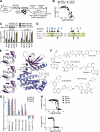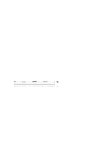Genetic resistance to JAK2 enzymatic inhibitors is overcome by HSP90 inhibition
- PMID: 22271575
- PMCID: PMC3280877
- DOI: 10.1084/jem.20111694
Genetic resistance to JAK2 enzymatic inhibitors is overcome by HSP90 inhibition
Abstract
Enzymatic inhibitors of Janus kinase 2 (JAK2) are in clinical development for the treatment of myeloproliferative neoplasms (MPNs), B cell acute lymphoblastic leukemia (B-ALL) with rearrangements of the cytokine receptor subunit cytokine receptor-like factor 2 (CRLF2), and other tumors with constitutive JAK2 signaling. In this study, we identify G935R, Y931C, and E864K mutations within the JAK2 kinase domain that confer resistance across a panel of JAK inhibitors, whether present in cis with JAK2 V617F (observed in MPNs) or JAK2 R683G (observed in B-ALL). G935R, Y931C, and E864K do not reduce the sensitivity of JAK2-dependent cells to inhibitors of heat shock protein 90 (HSP90), which promote the degradation of both wild-type and mutant JAK2. HSP90 inhibitors were 100-1,000-fold more potent against CRLF2-rearranged B-ALL cells, which correlated with JAK2 degradation and more extensive blockade of JAK2/STAT5, MAP kinase, and AKT signaling. In addition, the HSP90 inhibitor AUY922 prolonged survival of mice xenografted with primary human CRLF2-rearranged B-ALL further than an enzymatic JAK2 inhibitor. Thus, HSP90 is a promising therapeutic target in JAK2-driven cancers, including those with genetic resistance to JAK enzymatic inhibitors.
Figures






Similar articles
-
Heat shock protein 90 inhibitor is synergistic with JAK2 inhibitor and overcomes resistance to JAK2-TKI in human myeloproliferative neoplasm cells.Clin Cancer Res. 2011 Dec 1;17(23):7347-58. doi: 10.1158/1078-0432.CCR-11-1541. Epub 2011 Oct 5. Clin Cancer Res. 2011. PMID: 21976548 Free PMC article.
-
HSP90 inhibitor NVP-AUY922 enhances TRAIL-induced apoptosis by suppressing the JAK2-STAT3-Mcl-1 signal transduction pathway in colorectal cancer cells.Cell Signal. 2015 Feb;27(2):293-305. doi: 10.1016/j.cellsig.2014.11.013. Epub 2014 Nov 18. Cell Signal. 2015. PMID: 25446253 Free PMC article.
-
A potential role for HSP90 inhibitors in the treatment of JAK2 mutant-positive diseases as demonstrated using quantitative flow cytometry.Leuk Lymphoma. 2007 Nov;48(11):2189-95. doi: 10.1080/10428190701607576. Leuk Lymphoma. 2007. PMID: 17926180
-
Mechanisms of Resistance to JAK2 Inhibitors in Myeloproliferative Neoplasms.Hematol Oncol Clin North Am. 2017 Aug;31(4):627-642. doi: 10.1016/j.hoc.2017.04.003. Epub 2017 May 13. Hematol Oncol Clin North Am. 2017. PMID: 28673392 Review.
-
[Analysis of oncogenic signaling pathway induced by a myeloproliferative neoplasm-associated Janus kinase 2 (JAK2) V617F mutant].Yakugaku Zasshi. 2012;132(11):1267-72. doi: 10.1248/yakushi.12-00225. Yakugaku Zasshi. 2012. PMID: 23123718 Review. Japanese.
Cited by
-
Heterozygous and homozygous JAK2(V617F) states modeled by induced pluripotent stem cells from myeloproliferative neoplasm patients.PLoS One. 2013 Sep 16;8(9):e74257. doi: 10.1371/journal.pone.0074257. eCollection 2013. PLoS One. 2013. PMID: 24066127 Free PMC article.
-
Novel insights into the biology and treatment of chronic myeloproliferative neoplasms.Leuk Lymphoma. 2015 Jul;56(7):1938-48. doi: 10.3109/10428194.2014.974594. Epub 2014 Nov 19. Leuk Lymphoma. 2015. PMID: 25330439 Free PMC article. Review.
-
Ph-like acute lymphoblastic leukemia.Hematology Am Soc Hematol Educ Program. 2016 Dec 2;2016(1):561-566. doi: 10.1182/asheducation-2016.1.561. Hematology Am Soc Hematol Educ Program. 2016. PMID: 27913529 Free PMC article. Review.
-
The psoriasis-associated D10N variant of the adaptor Act1 with impaired regulation by the molecular chaperone hsp90.Nat Immunol. 2013 Jan;14(1):72-81. doi: 10.1038/ni.2479. Epub 2012 Dec 2. Nat Immunol. 2013. PMID: 23202271 Free PMC article.
-
Molecular classification of myeloproliferative neoplasms-pros and cons.Curr Hematol Malig Rep. 2013 Dec;8(4):342-50. doi: 10.1007/s11899-013-0179-9. Curr Hematol Malig Rep. 2013. PMID: 24091831 Review.
References
-
- Abramson J.S., Chen W., Juszczynski P., Takahashi H., Neuberg D., Kutok J.L., Takeyama K., Shipp M.A. 2009. The heat shock protein 90 inhibitor IPI-504 induces apoptosis of AKT-dependent diffuse large B-cell lymphomas. Br. J. Haematol. 144:358–366 10.1111/j.1365-2141.2008.07484.x - DOI - PMC - PubMed
-
- Baffert F., Régnier C.H., De Pover A., Pissot-Soldermann C., Tavares G.A., Blasco F., Brueggen J., Chène P., Drueckes P., Erdmann D., et al. 2010. Potent and selective inhibition of polycythemia by the quinoxaline JAK2 inhibitor NVP-BSK805. Mol. Cancer Ther. 9:1945–1955 10.1158/1535-7163.MCT-10-0053 - DOI - PubMed
-
- Cerchietti L.C., Lopes E.C., Yang S.N., Hatzi K., Bunting K.L., Tsikitas L.A., Mallik A., Robles A.I., Walling J., Varticovski L., et al. 2009. A purine scaffold Hsp90 inhibitor destabilizes BCL-6 and has specific antitumor activity in BCL-6-dependent B cell lymphomas. Nat. Med. 15:1369–1376 10.1038/nm.2059 - DOI - PMC - PubMed
Publication types
MeSH terms
Substances
Grants and funding
LinkOut - more resources
Full Text Sources
Other Literature Sources
Molecular Biology Databases
Miscellaneous

